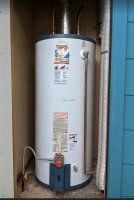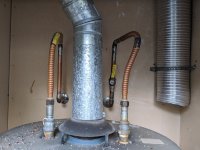Russell Harris
Member
Hello,
I am going to be replacing my 20 year old 75 gallon heater with a new 50-55 gallon heater. In reading specifications on the new heaters, I noticed that they often talk about the operating temp not being below 40 degrees or at least not in a location that freezes. I get the freezing I suppose due to the idea of pipes breaking. However, 20 years ago in our house remodel, the water heater was put in what is essentially an outside access closet. A small room that backs up to our utility room and is accessed via a steel insulated door on the outside of the house. There is no conditioned air put into the room. Just vented air from the attic space. You can see in the picture below. Now this all passed inspection and in the 20 years since, we've never had an issue. Probably the coldest it got during that time was maybe 15 degrees for a few hours one time. It's Austin, TX so never gets that cold.
(see attached pics)
Going forward should I be concerned or just replace the thing and move ahead? I plan on doing a PEX remodel of all our lines during this time but the 3/4" copper to the water heater would remain and be reused. Also, looking at the design and bend of the flex connections into the water heater, is there now a better/different/other way of doing that these days?
Thanks for any help/suggestions and if I need to clarify anything please ask.
RH in Austin
I am going to be replacing my 20 year old 75 gallon heater with a new 50-55 gallon heater. In reading specifications on the new heaters, I noticed that they often talk about the operating temp not being below 40 degrees or at least not in a location that freezes. I get the freezing I suppose due to the idea of pipes breaking. However, 20 years ago in our house remodel, the water heater was put in what is essentially an outside access closet. A small room that backs up to our utility room and is accessed via a steel insulated door on the outside of the house. There is no conditioned air put into the room. Just vented air from the attic space. You can see in the picture below. Now this all passed inspection and in the 20 years since, we've never had an issue. Probably the coldest it got during that time was maybe 15 degrees for a few hours one time. It's Austin, TX so never gets that cold.
(see attached pics)
Going forward should I be concerned or just replace the thing and move ahead? I plan on doing a PEX remodel of all our lines during this time but the 3/4" copper to the water heater would remain and be reused. Also, looking at the design and bend of the flex connections into the water heater, is there now a better/different/other way of doing that these days?
Thanks for any help/suggestions and if I need to clarify anything please ask.
RH in Austin


